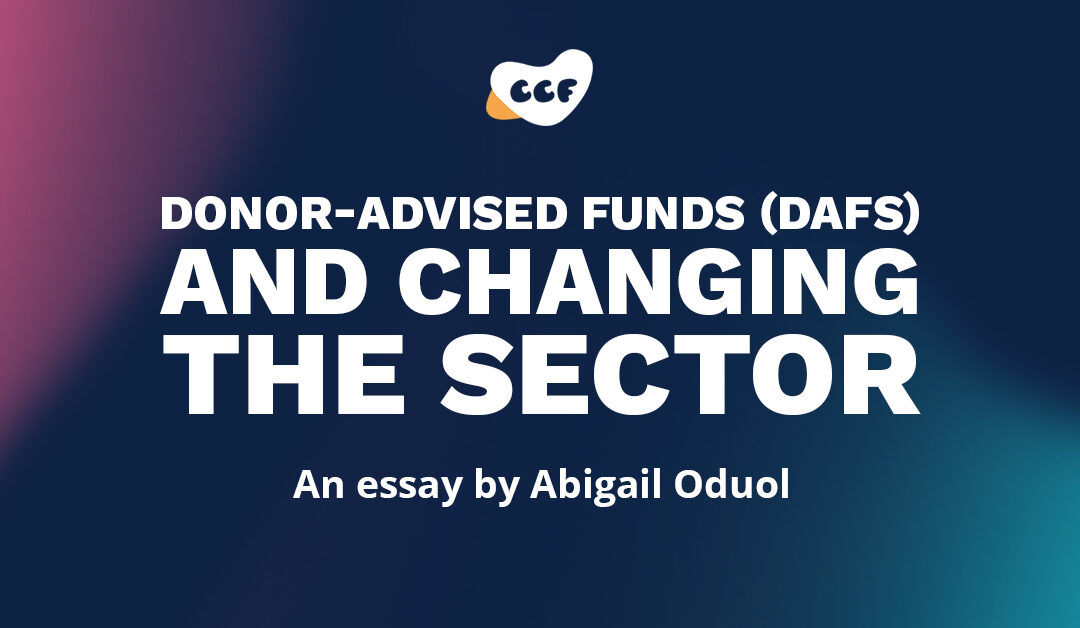By Abigail Oduol, a Black planned gift fundraiser in California
Some nonprofits and a lot of nonprofit workers they surveyed love those mysterious little packages from phantom donors. All I see is unfettered, hyper-individualistic capitalism with little structure to consider community needs.
FreeWill’s report on Donor-Advised Funds (DAFs) is out, and once again, I’m a minority in fundraising according to their research.
Some nonprofits and a lot of nonprofit workers they surveyed love those mysterious little packages from phantom donors. All I see is unfettered, hyper-individualistic capitalism with little structure to consider community needs.
You probably know what a Donor-Advised Fund is, but in case you do not, the National Philanthropic Trust describes it as “a giving account established at a public charity. The 501(c)(3) public charity serves as a ‘sponsoring organization,’ which manages and administers individual DAF accounts.
“DAF accounts allow donors to make a charitable contribution, receive an immediate tax deduction and then recommend grants from the fund over time.” (emphasis added). Here’s a deep dive into what lawyers in Canada, the U.S., and Australia are saying about DAFs.
We often are stuck discussing fundraisers and programmatic competency when talking about DAFs if LinkedIn and conferences are any indication of the conversations fundraisers are having. Do you accept them? What’s in your gift acceptance policy? How are you talking to donors about them? Are you building your capacity to identify them when they come in?
Because the air that we breathe is capitalist and the poisoned water we’ve been drinking from is donor centrism, we miss out on the larger picture of this newest gift vehicle.
In a recent piece for the CCF Hub, authors Maegan Vallejo and Nia Wassink gave some harrowing stats from their guide “Let’s Talk about DAFs,” which I encourage you to read, as well as the more robust guide that includes discussion and recommendations. Here, I’ll be focusing on two points they raised:
- IUPUI Lily Family School of Philanthropy reports, “$1.4 trillion is currently set aside in private foundations or DAFs and yet there is no evidence of DAFs increasing charitable giving.” The lack of payout requirements is actively harming the sector, and we need to figure out what to do about it.
- “There is a growing body of evidence to suggest that DAF dollars are only supporting the fund balances of their managing institutions.” We need a revolution among our finance sector friends. Based on how they are currently administered and used, DAFs will continue being harmful in our sector as they reinforce transactional interactions while we work on treating supporters as more than their contributions.
Wealth Hoarding… again
I’ve seen one foundation after another present at conferences, so excited about how much money they have under management. So pumped about the theoretical good they could do that charitable money spent charitably in real time has been deprioritized.
Currently, as a donor, I can put $10 million into a DAF, take the charitable tax deduction today, even spread it across multiple years, and never spend down the DAF.
Plus, if I didn’t list a beneficiary, it would just stay under management by the financial institution. Or maybe I designate that my child inherits it, and I could defer any kind of charitable decision-making for my lifetime. Then my child could theoretically defer for theirs and so on.
It feels like someone is pulling a massive prank on nonprofits with critical, time-sensitive missions.
Even when it’s a community foundation, which has legal requirements to guard against wealth hoarding and has a specific responsibility to the community, it is locked in the same pattern as its finance sector colleagues.
I’ve seen one foundation after another present at conferences, so excited about how much money they have under management. So pumped about the theoretical good they could do that charitable money spent charitably in real time has been deprioritized. Where are the financial institutions and community foundations with DAF mandatory spend downs? I’ve heard they exist, or maybe they’re just a few fundraisers’ imaginary friends. If I believe hard enough, maybe they’ll become real for me, too.
Community foundations: I love some of the work you’re doing. You’re making change happen locally and partnering with local governments and private entities. Kudos.
Some of you aren’t even meeting your 5% spend-down floor requirement, but I’m not talking about that or you right now. Here are eloquent pieces for that situation.
Anti-Racism Daily said it well: when you give money to a foundation or a DAF, it is a fund that holds money for charitable purposes, which means it is no longer yours, and you have agreed to “relinquish dominion and control” of the funds (Cornell Law); they do not own the money any more…the organization or fund may include their name, but they don’t own that either—no one does. It exists to serve the public good.”
Retrain your supporters and staff to understand that you can make DAF rules because your role is to serve the public good. The role of these accounts is to serve the public good. If you’re not feeling particularly creative, you could hold them to the same (incredibly loose) standard you are held to as a starting point. Tell your DAF holders to cut the check.
My metrics promote wealth hoarding
I won’t just pick on community foundations. DAF holding institutions are also charitable arms of large for-profit financial institutions that exist to make money and benefit their shareholders. They don’t seem to have a vested interest in those funds being distributed to the community.
It’s probably because the amount of money under management is one of the ways their performance is evaluated. Therefore, why learn how a DAF holder might use their funds better and more quickly?
In my work in planned giving, I’m also noticing that individuals and their advisors are often only viewing philanthropy as solely a tax deduction, rather than considering the disturbing inequities that created, maintain and make the sector a necessity.
Treating donations as “just” a tax harbor for indecisive people with disposable assets is exploiting a loophole. It allows individuals to benefit in the short term while communities and charities wait indefinitely to benefit. As a result, we have people like the owner of X, making money from laborers but not reinvesting in any part of the system that provided the labor for their riches.
What should we do about it?
Solicit DAF gifts or don’t. Pursue reforms or not. I’m less concerned about one-off individual actions and more about what we can do collectively as fundraisers who are in many corners of the sector multiverse.
I believe in grassroots community organizing as a means of leveraging people power. We have not succeeded in passing legislation yet, but as a movement, we collectively drove philanthropy to have conversations and grapple with topics in a meaningful way that is still having ripple effects across the sector.
Those are victories. Let’s keep it going.
I call on people who work in foundations to drive forward conversations collectively and individually about what their DEI work looks like. Consider internal rules that require any DAFs you are holding to have, at a minimum, the same spend-down requirement as the foundation itself.
While we’re on the topic, increase the amount you spend to fund your community. Some of you have done a lot of good; what if you did… more? I call on leaders within foundations to encourage staff to have hard conversations with the donors setting up DAFs.
Have conversations with donors about the purpose of a community foundation and that supporting the community involves not just intentions but action—not just safe-harboring money, but using it for good.
Because organizations are fighting for their lives right now, we can’t afford to wait for a rainy day when we’re in a hurricane that we might not survive. So many people have already said this eloquently and frequently.
I call on fundraisers to make friends with financial managers and wealth managers. Get your financial advisor credentials and network, and include this in your work to introduce our colleagues in the finance sector to CCF ideas.
Find them in your local fundraising chapters. Find them in their Patagonia vests at the bar across the street from the giant Fidelity building. Follow groups trying to drive forward similar efforts.
Just like we learned how to look at our work more holistically and shift the conversation, finance professionals might be doing similar things, too. We must find the folks who are doing the work and join with them because the finance sector is a part of the story of what is happening in philanthropy. They need to reconsider how they are advising clients about their work involving DAFs and beneficiary designations to better promote harmony and progress within our shared ecosystem. And while they’re at it, maybe your new finance friend will get you Patagonia swag.

Abigail Oduol
Abigail Oduol’s (she/hers) surname is not Irish or Pennsylvania Dutch. It’s Kenyan. She keeps her escape pod in Kenya ready, and checks on it regularly with her young kids and husband. Abigail serves on the CCF Global Council, NACGP D&I committee and with her local PTA. You can follow her on LinkedIn, and can send tips and micro reparations to her Cashapp $AbbyOduol.
Discover more from CCF
Subscribe to get the latest posts sent to your email.


Great article! It’s been great to see some awareness growing with the pushes for congressional legislation in recent years to force spend downs. Unfortunately our foes are philanthropy itself! The main lobby against DAF reforms is both firms like Fidelity and Vanguard and institutionalized philanthropy.
Check out Seeding Justice website. They are pioneering a new model of donor advised funds that is very CCF aligned! I hope it spreads!
Gah so frustrating. I believe in the power of a beautiful message of more than just funds under management! Yes I will check that out thank you!
Excellent article thank you! DAF’s are the dark money of philanthropy. When you research funders the largest ones are, without exception, DAFs. I tell people that our communities lose twice, once because of the taxes they are not receiving as a result of the DAF donation and again when the money just sits in Fidelity or similar account and is not given to the community. Worse, I am seeing a worrying trend of more donors giving to DAFs instead of local causes. As I’m sure you know, inequality.org and others have put forth legislation to require DAFs to have a minimum payout requirement. (introduced but not passed last time they tried). Thank you for raising awareness of this important issue.
Yes! I’m hoping that if we continue socializing what we can do about it and sharing with donors the impact their choices have as well as with advisors people can change their behavior.
Thank you Abigail for saying what needs to be said. We have $225 BILLION dollars sitting in DAF accounts that could be reducing hunger, supporting college educations, advancing racial justice and so much more.
It is a huge scam mostly benefiting the financial industry and slowing progress in social impact.
Let’s keep speaking out and organizing to get those dollars moving into movements!
Yes I totally agree. Id love to reply all, release the money! Now would be good, k thanks ^.^